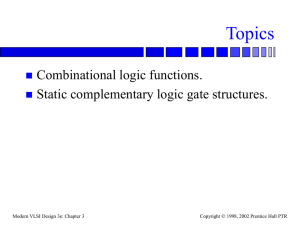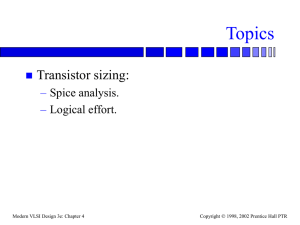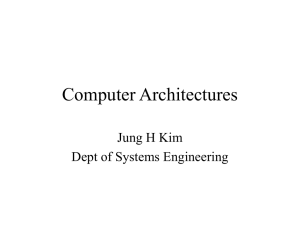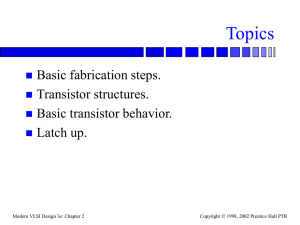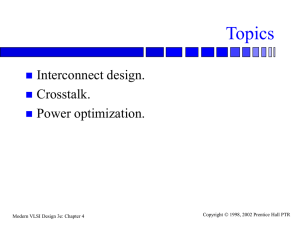CHAP3-3
advertisement
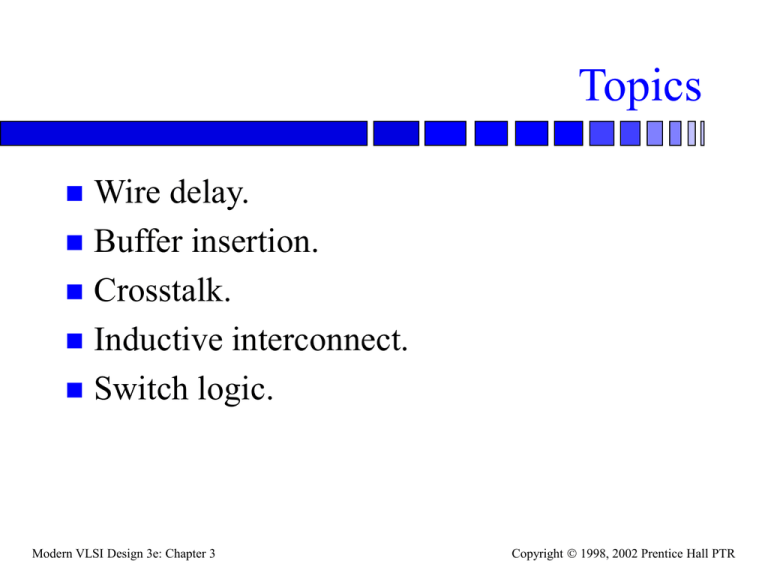
Topics
Wire delay.
Buffer insertion.
Crosstalk.
Inductive interconnect.
Switch logic.
Modern VLSI Design 3e: Chapter 3
Copyright 1998, 2002 Prentice Hall PTR
Wire delay
Wires have parasitic resistance, capacitance.
Parasitics start to dominate in deepsubmicron wires.
Distributed RC introduces time of flight
along wire into gate-to-gate delay.
Modern VLSI Design 3e: Chapter 3
Copyright 1998, 2002 Prentice Hall PTR
RC transmission line
Assumes that dominant capacitive coupling
is to ground, inductance can be ignored.
Elemental values are ri, ci.
Modern VLSI Design 3e: Chapter 3
Copyright 1998, 2002 Prentice Hall PTR
Elmore delay
Elmore defined delay through linear
network as the first moment of the network
impulse response.
Modern VLSI Design 3e: Chapter 3
Copyright 1998, 2002 Prentice Hall PTR
RC Elmore delay
Can be computed as sum of sections:
E = r(n - i)c = 0.5 rcn(n-1)
Resistor ri must charge all downstream
capacitors.
Delay grows as square of wire length.
Minimizing rc product minimizes growth of
delay with increasing wire length.
Modern VLSI Design 3e: Chapter 3
Copyright 1998, 2002 Prentice Hall PTR
RC transmission lines
More complex analysis.
Step response:
– V(t) @ 1 + K1 exp{-s1t/RC}.
Modern VLSI Design 3e: Chapter 3
Copyright 1998, 2002 Prentice Hall PTR
Wire sizing
Wire length is determined by layout
architecture, but we can choose wire width
to minimize delay.
Wire width can vary with distance from
driver to adjust the resistance which drives
downstream capacitance.
Modern VLSI Design 3e: Chapter 3
Copyright 1998, 2002 Prentice Hall PTR
Optimal wiresizing
Wire with minimum delay has an
exponential taper.
Optimal tapering improves delay by about
8%.
Modern VLSI Design 3e: Chapter 3
Copyright 1998, 2002 Prentice Hall PTR
Approximate tapering
Can approximate optimal tapering with a few
rectangular segments.
Modern VLSI Design 3e: Chapter 3
Copyright 1998, 2002 Prentice Hall PTR
Tapering of wiring trees
Different branches of tree can be set to
different lengths to optimize delay.
source
sink 1
sink 2
Modern VLSI Design 3e: Chapter 3
Copyright 1998, 2002 Prentice Hall PTR
Spanning tree
A spanning tree has segments that go directly
between sources and sinks.
source
sink 1
sink 2
Modern VLSI Design 3e: Chapter 3
Copyright 1998, 2002 Prentice Hall PTR
Steiner tree
A Steiner point is an intermediate point for the
creation of new branches.
source
Steiner point
sink 1
sink 2
Modern VLSI Design 3e: Chapter 3
Copyright 1998, 2002 Prentice Hall PTR
RC trees
Generalization of RC transmission line.
Modern VLSI Design 3e: Chapter 3
Copyright 1998, 2002 Prentice Hall PTR
Buffer insertion in RC
transmission lines
Assume RC transmission line.
Assume R0 is driver’s resistance, C0 is
driver’s input capacitance.
Want to divide line into k sections of length
l. Each buffer is of size h.
Modern VLSI Design 3e: Chapter 3
Copyright 1998, 2002 Prentice Hall PTR
Buffer insertion analysis
Assume h = 1:
– k = sqrt{(0.4 Rint Cint)/(0.7R0 C0)}
Assume arbitrary h:
– k = sqrt{(0.4 Rint Cint)/(0.7R0 C0)}
– h = sqrt{(R0 Cint)/(Rint C0)}
– T50% = 2.5 sqrt{R0 C0 Rint Cint}
Modern VLSI Design 3e: Chapter 3
Copyright 1998, 2002 Prentice Hall PTR
Buffer insertion example
Minimum-size inverter drives metal 1 wire
of 2000 l x 3 l.
– R0 = 3.9 kW, C0 = 0.68 fF, Rint = 53.3 kW, Cint =
105.1 fF.
Then
– k = 1.099.
– H = 106.33.
– T50% = 9.64 E-12
Modern VLSI Design 3e: Chapter 3
Copyright 1998, 2002 Prentice Hall PTR
RC crosstalk
Crosstalk slows down signals---increases
settling noise.
Two nets in analysis:
– aggressor net causes interference;
– victim net is interfered with.
Modern VLSI Design 3e: Chapter 3
Copyright 1998, 2002 Prentice Hall PTR
Aggressors and victims
aggressor net
victim net
Modern VLSI Design 3e: Chapter 3
Copyright 1998, 2002 Prentice Hall PTR
Wire cross-section
Victim net is surrounded by two aggressors.
S
aggressor
W
T victim
aggressor
H
substrate
Modern VLSI Design 3e: Chapter 3
Copyright 1998, 2002 Prentice Hall PTR
relative RC delay
Crosstalk delay vs. wire aspect
ratio
increased spacing
Increasing aspect ratio
Modern VLSI Design 3e: Chapter 3
Copyright 1998, 2002 Prentice Hall PTR
Crosstalk delay
There is an optimum wire width for any
given wire spacing---at bottom of U curve.
Optimium width increases as spacing
between wires increases.
Modern VLSI Design 3e: Chapter 3
Copyright 1998, 2002 Prentice Hall PTR
RLC transmission lines
Most results come from curve fitting.
Propagation delay is largely a factor of x.
50% propagation delay can be calculated in
terms of x.
Modern VLSI Design 3e: Chapter 3
Copyright 1998, 2002 Prentice Hall PTR
Switch logic
Can implement Boolean formulas as
networks of switches.
Can build switches from MOS transistors—
transmission gates.
Transmission gates do not amplify but have
smaller layouts.
Modern VLSI Design 3e: Chapter 3
Copyright 1998, 2002 Prentice Hall PTR
Types of switches
Modern VLSI Design 3e: Chapter 3
Copyright 1998, 2002 Prentice Hall PTR
Behavior of n-type switch
n-type switch has source-drain voltage drop
when conducting:
– conducts logic 0 perfectly;
– introduces threshold drop into logic 1.
VDD
VDD - Vt
VDD
Modern VLSI Design 3e: Chapter 3
Copyright 1998, 2002 Prentice Hall PTR
n-type switch driving static logic
Switch underdrives static gate, but gate
restores logic levels.
VDD
VDD - Vt
VDD
Modern VLSI Design 3e: Chapter 3
Copyright 1998, 2002 Prentice Hall PTR
n-type switch driving switch
logic
Voltage drop causes next stage to be turned on
weakly.
VDD
VDD - Vt
VDD
Modern VLSI Design 3e: Chapter 3
Copyright 1998, 2002 Prentice Hall PTR
Behavior of complementary
switch
Complementary switch products full-supply
voltages for both logic 0 and logic 1:
– n-type transistor conducts logic 0;
– p-type transistor conducts logic 1.
Modern VLSI Design 3e: Chapter 3
Copyright 1998, 2002 Prentice Hall PTR
Layout characteristics
Has two source/drain areas compared to one
for inverter.
Doesn’t have gate capacitance.
Modern VLSI Design 3e: Chapter 3
Copyright 1998, 2002 Prentice Hall PTR
